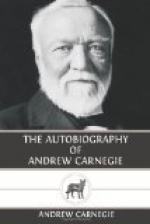My first important enterprise after settling in New York was undertaking to build a bridge across the Mississippi at Keokuk.[29] Mr. Thomson, president of the Pennsylvania Railroad, and I contracted for the whole structure, foundation, masonry, and superstructure, taking bonds and stocks in payment. The undertaking was a splendid success in every respect, except financially. A panic threw the connecting railways into bankruptcy. They were unable to pay the stipulated sums. Rival systems built a bridge across the Mississippi at Burlington and a railway down the west side of the Mississippi to Keokuk. The handsome profits which we saw in prospect were never realized. Mr. Thomson and myself, however, escaped loss, although there was little margin left.
[Footnote 29: It was an iron bridge 2300 feet in length with a 380-foot span.]
The superstructure for this bridge was built at our Keystone Works in Pittsburgh. The undertaking required me to visit Keokuk occasionally, and there I made the acquaintance of clever and delightful people, among them General and Mrs. Reid, and Mr. and Mrs. Leighton. Visiting Keokuk with some English friends at a later date, the impression they received of society in the Far West, on what to them seemed the very outskirts of civilization, was surprising. A reception given to us one evening by General Reid brought together an assembly creditable to any town in Britain. More than one of the guests had distinguished himself during the war and had risen to prominence in the national councils.
The reputation obtained in the building of the Keokuk bridge led to my being applied to by those who were in charge of the scheme for bridging the Mississippi at St. Louis, to which I have already referred. This was connected with my first large financial transaction. One day in 1869 the gentleman in charge of the enterprise, Mr. Macpherson (he was very Scotch), called at my New York office and said they were trying to raise capital to build the bridge. He wished to know if I could not enlist some of the Eastern railroad companies in the scheme. After careful examination of the project I made the contract for the construction of the bridge on behalf of the Keystone Bridge Works. I also obtained an option upon four million dollars of first mortgage bonds of the bridge company and set out for London in March, 1869, to negotiate their sale.
During the voyage I prepared a prospectus which I had printed upon my arrival in London, and, having upon my previous visit made the acquaintance of Junius S. Morgan, the great banker, I called upon him one morning and opened negotiations. I left with him a copy of the prospectus, and upon calling next day was delighted to find that Mr. Morgan viewed the matter favorably. I sold him part of the bonds with the option to take the remainder; but when his lawyers were called in for advice a score of changes were required in the wording of the bonds. Mr. Morgan said to me that as I was going to Scotland I had better go now; I could write the parties in St. Louis and ascertain whether they would agree to the changes proposed. It would be time enough, he said, to close the matter upon my return three weeks hence.




